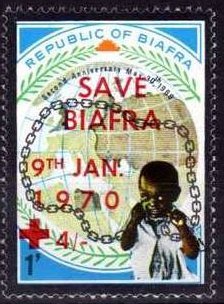Stamp: Symbolic representation (Biafra 1970)
Symbolic representation (Biafra 1970)
09 January (Biafra ) within release Overprint SAVE BIAFRA goes into circulation Stamp Symbolic representation face value 1+4 Biafran shilling
| Stamp Symbolic representation in catalogues | |
|---|---|
| Michel: | Mi:BIA 52 |
Stamp is square format.
overprintedAlso in the issue Overprint SAVE BIAFRA:
- Stamp - Symbolic representation face value 2+8;
- Stamp - Symbolic representation face value 4+¼;
- Stamp - Symbolic representation face value 1+4;
- Stamp - Symbolic representation face value 2'6+10;
- Stamp - Orphans face value 10+1;
- Souvenir Sheet - Orphans face value 10+1;
- Souvenir Sheet - Orphans face value 10+1;
Stamp Symbolic representation it reflects the thematic directions:
A map is a symbolic depiction emphasizing relationships between elements of some space, such as objects, regions, or themes. Many maps are static, fixed to paper or some other durable medium, while others are dynamic or interactive. Although most commonly used to depict geography, maps may represent any space, real or imagined, without regard to context or scale, such as in brain mapping, DNA mapping, or computer network topology mapping. The space being mapped may be two dimensional, such as the surface of the earth, three dimensional, such as the interior of the earth, or even more abstract spaces of any dimension, such as arise in modeling phenomena having many independent variables. Although the earliest maps known are of the heavens, geographic maps of territory have a very long tradition and exist from ancient times. The word "map" comes from the medieval Latin Mappa mundi, wherein mappa meant napkin or cloth and mundi the world. Thus, "map" became the shortened term referring to a two-dimensional representation of the surface of the world.
Biologically, a child (plural: children) is a human being between the stages of birth and puberty. The legal definition of child generally refers to a minor, otherwise known as a person younger than the age of majority. Child may also describe a relationship with a parent (such as sons and daughters of any age) or, metaphorically, an authority figure, or signify group membership in a clan, tribe, or religion; it can also signify being strongly affected by a specific time, place, or circumstance, as in "a child of nature" or "a child of the Sixties". There are many social issues that affect children, such as childhood education, bullying, child poverty, dysfunctional families, child labor, hunger, and child homelessness. Children can be raised by parents, by fosterers, guardians or partially raised in a day care center.


